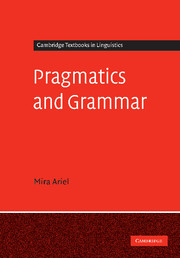Book contents
- Frontmatter
- Contents
- List of tables
- Preface
- Acknowledgments
- How to use this book
- Transcription conventions
- 1 Introduction: Grammar, pragmatics, and what's between them
- PART I Drawing the grammar/pragmatics divide
- PART II Crossing the extralinguistic/linguistic divide
- Part III Bringing grammar and pragmatics back together
- References
- Author index
- Subject index
PART I - Drawing the grammar/pragmatics divide
Published online by Cambridge University Press: 05 September 2012
- Frontmatter
- Contents
- List of tables
- Preface
- Acknowledgments
- How to use this book
- Transcription conventions
- 1 Introduction: Grammar, pragmatics, and what's between them
- PART I Drawing the grammar/pragmatics divide
- PART II Crossing the extralinguistic/linguistic divide
- Part III Bringing grammar and pragmatics back together
- References
- Author index
- Subject index
Summary
Introduction
Using an utterance, whether as a speaker or as an addressee, seems to be a smooth, uniform type of activity. As speakers we have one mission, to select some string of words to convey our message, and as addressees we also have one mission, to interpret that string as conveying that very message. A closer examination, however, reveals that two quite distinct procedures are actually implemented in each act. The first comprises encoding or decoding, the second, triggering or drawing inferences. Codes are stipulated conventions associating specifically linguistic expressions with their formal or functional use conditions. Inferencing is not unique to linguistic competence or signs. It is based on our general cognitive abilities in drawing on various assumptions and deriving conclusions based on those assumptions.
Chapter 1 introduced the code/inference distinction between grammar and pragmatics. It focused on interpretations whose pragmatic status is for the most part not in dispute (conversational implicatures). Codes and inferences complement each other according to this approach, each making its unique contribution to our use and interpretation of natural discourse. Part I is devoted to drawing the grammar/pragmatics division of labor for less obvious cases. Chapter 2 focuses on referential expressions, and provides arguments for drawing the division of labor between interpretations and use conditions whose grammatical/pragmatic status is not self-evident. Chapter 3 too discusses the code/inference divide, but adding another question: given that some interpretation is pragmatic (rather than grammatical), what pragmatic status should it receive?
- Type
- Chapter
- Information
- Pragmatics and Grammar , pp. 25 - 26Publisher: Cambridge University PressPrint publication year: 2008



